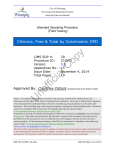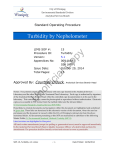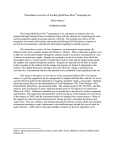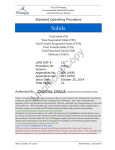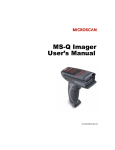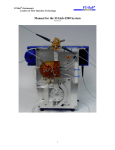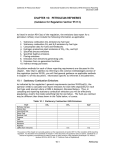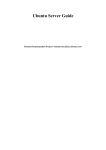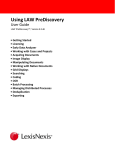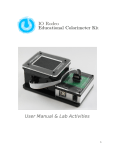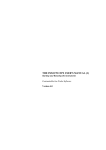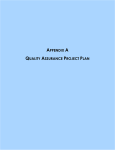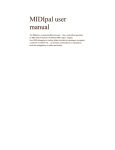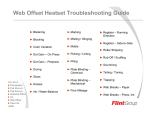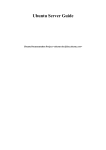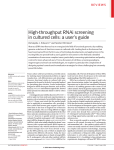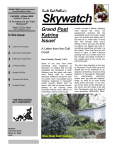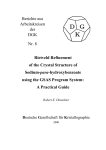Download Ammonia Nitrogen, Nitrate-Nitrite Nitrogen
Transcript
City of Winnipeg Environmental Standards Division Analytical Services Branch Standard Operating Procedure Ammonia Nitrogen, Nitrate + Nitrite Nitrogen & ortho-Phosphate by Flow Injection Analysis op y 6 FIA 5.1 001 (NH3) 004 (NO3) 014 (PO4) October 28, 2014 28 Courtney Diduck, Analytical Services Branch Head U no Approved By: ffi c ia lC LIMS SOP No: Procedure ID: Version: Appendices No: Appendices No: Appendices No: Issue Date: Total Pages: Notice: Only one printed control copy is issued and is located in the Analytical Services Laboratory. The controlled copy is authorized by signature of the Analytical Services Branch Head. Only the controlled copy documentation is to be used in the laboratory. This controlled copy cannot be photocopied or reproduced without authorization. Electronic copies are accessible in PDF format from the method folder and the intranet folder; N:\Environmental Standards\Analytical Services\SOP (PDFs) Hyperlinks to external documents and navigation within this document are highlighted and underlined in green font. These links are functional in the electronic version of this document, when the user has permission and the document is viewed within the City of Winnipeg’s intranet site from the above mentioned folder. All documents pertaining to this SOP are maintained in subfolders of the following Master Folder; N:\Environmental Standards \Methods\FIA (SOP 06) Latest revisions are highlighted in blue print. All hand-written amendments (except for spelling or grammatical errors) must be approved immediately by the Analytical Services Branch Head or Quality Assurance Officer, who shall initial and date the amendments. The procedure shall be formally revised and reissued as soon as practicable. SOP-06_FIA_v5-1.docx -1- Date Printed: 11/18/2014 Accredited Test Procedure Name: NH3, NO3-NO2, & PO4 by Flow Injection Analysis Analytical Services Branch Method Date: October 28, 2014 Environmental Standards Division Page 2 of 28 Table of Contents All forms, reagent logs are located in; FIA-Forms.xls1 Control Charts are printed from; ChartGenerator.xlsm2 Table of Contents ................................................................................................... 2 Introduction and Scope............................................................................................ 4 Scope........................................................................................................................................... 4 Instrument Range .......................................................................................................................... 4 Operating Range............................................................................................................................ 4 Minimum Detectable Limits ............................................................................................................. 4 Bias ............................................................................................................................................. 4 Precision....................................................................................................................................... 4 Expanded Uncertainty, Ue ............................................................................................................... 4 Referenced Methods ....................................................................................................................... 5 Summary of Method ................................................................................................ 6 y LIMS Test Codes ................................................................................................................ 6 op Sample Requirements ............................................................................................. 6 Sample History .................................................................................................................. 6 lC Field Filtration ............................................................................................................................... 6 Containers .................................................................................................................................... 6 Volume Required ........................................................................................................................... 6 Sample Collection .......................................................................................................................... 7 Laboratory Filtration....................................................................................................................... 7 Preservation.................................................................................................................................. 7 Holding Time ................................................................................................................................. 7 Sample Pretreatment ..................................................................................................................... 7 ia Interferences ..................................................................................................................... 7 ffi c Ammonia ...................................................................................................................................... 7 Nitrate/Nitrite ................................................................................................................................ 8 Ortho-phosphorus .......................................................................................................................... 8 Chemicals & Reagents ............................................................................................. 8 U no Reagent Preparation Logs .................................................................................................... 8 Storage ............................................................................................................................. 8 Degassing ......................................................................................................................... 8 Purchased Reagents ....................................................................................................................... 9 Back up Reagents ............................................................................................................... 9 Ammonia Chemicals & Reagents ............................................................................... 9 Purchased Ammonia Reagents & Standards ........................................................................... 9 Prepared Reagents & Standards ........................................................................................... 9 Nitrate (Nitrite) Chemicals & Reagents ....................................................................... 9 Purchased Nitrate Reagents & Standards .............................................................................. 10 Lachat Reagent Set: Nitrate (Part No: 52903) ................................................................................. 10 Prepared Reagents & Standards .......................................................................................... 10 ortho-Phosphorus (Phosphate) Chemicals & Reagents ................................................. 10 Purchased Phosphate Reagents & Standards ......................................................................... 10 Prepared Reagents & Standards .......................................................................................... 10 Selection of Daily Working Standards ....................................................................... 11 Daily Working Calibration Standards with Low Level Ammonia ................................................ 11 Daily Working Calibration Standards High Level Ammonia ...................................................... 11 Spiking Procedures ............................................................................................................ 12 High Level Ammonia .................................................................................................................... 12 Low Level Ammonia Analysis ......................................................................................................... 12 Equipment ........................................................................................................... 12 Common Tubing Sizes and Setup ................................................................................................... 13 Equipment Maintenance Logs .............................................................................................. 13 Maintenance ..................................................................................................................... 13 SOP-06_FIA_v5-1.docx -2- Date Printed: 10/27/2014 Accredited Test Procedure Name: NH3, NO3-NO2, & PO4 by Flow Injection Analysis Analytical Services Branch Method Date: October 28, 2014 Environmental Standards Division Page 3 of 28 Manifold Cleaning ........................................................................................................................ 13 Cadmium-Copper Reduction Column .................................................................................... 14 Replacement ............................................................................................................................... 14 Column Efficiency Test ................................................................................................................. 14 Quick Regeneration of the Cadmium Column2 .................................................................................. 14 Glassware Preparation ....................................................................................................... 15 Quality Control Plan .............................................................................................. 15 Method Quality Control....................................................................................................... 15 Acceptance Criteria ............................................................................................................ 16 Non-Conformance and Corrective Action .............................................................................. 16 Proficiency Testing ............................................................................................................. 17 Test Procedure ..................................................................................................... 18 y Batch Creation .................................................................................................................. 18 Instrument Setup .............................................................................................................. 18 Instrument Start-up .......................................................................................................... 19 Calibration Procedure ......................................................................................................... 19 Preparation of bulk Concentrated Phosphoric Acid Sample ...................................................... 20 Sample Analysis ................................................................................................................ 21 System Shutdown Procedure .............................................................................................. 21 op Data Analysis & Calculations ................................................................................... 21 File Export Procedure ................................................................................................................... 22 Instrument Files and Results ......................................................................................................... 22 of of of of Duplicates or Repeats .................................................................................... 22 %Recovery ................................................................................................... 22 Spike Recoveries ........................................................................................... 22 Phosphoric Acid % Concentration (75%) .......................................................... 23 lC Calculation Calculation Calculation Calculation ia Safety................................................................................................................. 23 Revision History ................................................................................................... 24 Current Version, 5.1 .......................................................................................................... 24 ffi c Document Control ................................................................................................. 25 Hard Copy Documents ....................................................................................................... 25 Computer/Data Backup and Storage Procedure ..................................................................... 25 Appendices & Method Binder Tabs ........................................................................... 26 U no Appendix A: Manifold Diagrams ..................................................................................................... Appendix B: Omnion Software Settings .......................................................................................... Appendix C: Instrument Settings ................................................................................................... Binder Tab: Ammonia LL .............................................................................................................. Binder Tab: Ammonia................................................................................................................... Binder Tab: Nitrate ...................................................................................................................... Binder Tab: Nitrite ....................................................................................................................... Binder Tab: Ortho-P ..................................................................................................................... Binder Tab: Daily Working Calibration Standards ............................................................................. Binder Tab: Method Validation ....................................................................................................... Binder Tab: Cadmium Column Replacement Instructions and Diagrams .............................................. Binder Tab: SWI-06a, Routine Maintenance Procedures .................................................................... Binder Tab: SWI-06b, FIA-Reagents............................................................................................... 26 26 26 26 26 26 26 26 26 26 26 26 26 References .......................................................................................................... 27 Referenced Methods ..................................................................................................................... Supporting Test Methods .............................................................................................................. Equipment Instruction Manuals...................................................................................................... Computer Software Documentation ................................................................................................ 27 27 27 27 Endnotes (file and folder locations) ...................................................................................... 28 Appendix A: ManifoldDiagrams Appendix B: SoftwareSetup Appendix C: InstrumentSettings SOP-06_FIA_v5-1.docx -3- Date Printed: 10/27/2014 Accredited Test Procedure Name: NH3, NO3-NO2, & PO4 by Flow Injection Analysis Analytical Services Branch Method Date: October 28, 2014 Environmental Standards Division Page 4 of 28 Introduction and Scope Nitrogen exists in several forms in the environment including nitrate, nitrite, and ammonia. Ammonia is a colorless gaseous compound with a pungent odor, highly soluble in water. It is present in most surface and wastewaters as a result of biological degradation of nitrogenous organic matter and by hydrolysis of urea. There are also industrial and agricultural sources and in some wastewater and water treatment plants, ammonia is added to react with chlorine to form combined chlorine residuals (chloramines). y Nitrate and nitrite are naturally occurring ions, which are widely distributed in the environment. Both are products of the oxidation of nitrogen by microorganisms in plants, soil, and water. Nitrate is the more stable form of oxidized nitrogen. Sources of nitrates in water include decaying plant or animal material, excess amounts of inorganic fertilizers. Nitrites may be produced from excess ammonia in a drinking water distribution system that uses chloramines as a disinfectant. lC op Phosphorus occurs in natural waters and in wastewaters almost solely as phosphates in the form orthophosphates from detergents, fertilizer, condensed phosphates and organically bound phosphates in sewage that are contributed by body wastes and food residues. Phosphorus is essential to the growth of organisms but excess discharge into bodies of water can stimulate the growth of photosynthetic aquatic organisms in nuisance quantities. ffi c ia Filtration through 0.45 um membrane filter separates dissolved phosphorus from suspended forms of phosphorus. The phosphorus content of a filtered sample that reacts to colorimetric tests without sample hydrolysis or digestion is identified as dissolved reactive phosphorus. Although this is not a true representation of orthophosphate, it is reproducible and reported as ortho-phosphorus. A non-filtered sample without hydrolysis or digestion is identified as total dissolved reactive and reported as total orthophosphate. Scope The Analytical Services Branch of Environmental Standards Division is currently accredited for Ammonia and Nitrate + Nitrite Nitrogen and certified for Phosphate. U no This method pertains to the determination of; Total Ammonia Nitrogen, Nitrate plus Nitrite Nitrogen, dissolved reactive Phosphorus, and total dissolved reactive Phosphorus in surface water, ground water, wastewater and sludge. Units Ammonia Nitrogen Ammonia Nitrogen Low Level High Level Nitrate + Nitrite Nitrogen Ortho Phosphorus Instrument Range mg/L 0.02 to 2.0 0.2 to 20 0.003 to 2.0 0.05 to 2.0 Operating Range mg/L 0.02 to 2.0 0.2 to >40 0.01 to >10 Minimum Detectable Limits Accuracy mg/L 0.003 0.013* 0.003 0.05 to >10 mg 0.013 Bias -0.039 0.007 0.005 -0.017 Precision 0.059 0.062 0.059 0.058 0.165 0.068 0.078 0.075 Expanded Uncertainty, Ue *Samples below 0.1 are often re-analyzed on the Ammonia, Low Level procedure SOP-06_FIA_v5-1.docx -4- Date Printed: 10/27/2014 Accredited Test Procedure Name: NH3, NO3-NO2, & PO4 by Flow Injection Analysis Analytical Services Branch Method Date: October 28, 2014 Environmental Standards Division Page 5 of 28 Referenced Methods This Ammonia method is modified from Standard Methods for the Examination of Water and Wastewater3, 4500-NH3 H. Flow Injection Analysis, approved by Standard Methods Committee 1997, Editorial Revisions 2011, , with the following modifications; All samples are filtered through 0.45 um glass fiber filter Samples are degassed by vacuum suction, only if there is a problem with air bubbles, All reagents are made by volume instead of by weight and most reagents are purchased as prepared solutions. Samples are refrigerated for up to 7 days. This Nitrate method is modified from Standard Method for the Examination of Water and Wastewater3, 4500-NO3 I. Cadmium Reduction Flow Injection Method approved by Standard Methods Committee 2000, Editorial Revisions 2011, , with the following modifications; y op lC The detector is set at 520 nm instead of 540 nm, The Ammonium Chloride Buffer, as per Lachat Quick-Chem procedure, is made with 85 g ammonium chloride, not the 55.6 g of NH4OH (in Std Methods), Samples are degassed by vacuum suction, only if there is a problem with air bubbles, All reagents are made by volume instead of by weight and most reagents are purchased as prepared solutions, The Cadmium-copper reduction column is purchased (not prepared) but it is regenerated to extend its life (procedure included), Samples are refrigerated for up to 7 days. ia ffi c This Phosphate3 method is modified from Standard Method for the Examination of Water and Wastewater, 4500-P G, Flow Injection Analysis for Orthophosphate, approved by Standard Methods Committee 1997, Editorial Revisions 2011, , with the following modifications; Samples are degassed by vacuum suction, only if there is a problem with air bubbles, All reagents are made by volume instead of by weight and most reagents are purchased as prepared solutions. Samples are refrigerated for up to 7 days. U no All tubing sizes and flow rates are based on the equipment operation manual and vendor method. See Method Binder Tab: Method Validation4 in the document binder for Fit-For-Use statements and scope of testing. SOP-06_FIA_v5-1.docx -5- Date Printed: 10/27/2014 Accredited Test Procedure Name: NH3, NO3-NO2, & PO4 by Flow Injection Analysis Analytical Services Branch Method Date: October 28, 2014 Environmental Standards Division Page 6 of 28 Summary of Method The Lachat QuickChem® analyzer is a flow injection analyzer capable of simultaneous analysis of up to 6 channels. The current setup has four channels, with two dedicated to the ammonia; one for low level and the more frequently used for mid to high level. Only one Ammonia channel is run in parallel with the ortho Phosphorus and Nitrate + Nitrite Nitrogen channels. y The Ammonia method is based on the Berthelot reaction. Ammonia reacts with alkaline phenol, and sodium hypochlorite to form indophenol blue. Sodium nitroprusside (nitroferricyanide) is added to enhance sensitivity. The absorbance of the reaction product is measured at 630 nm, and is directly proportional to the original ammonia concentration in the sample. The difference between the low level and the mid-high level is the long sample loop in the low level, and lower calibration standard concentration. The longer loop is required for lower detection by using the longer “path length”, i.e. controlled by a longer read time/baseline peak. lC op Nitrate is quantitatively reduced to nitrite by passage of the sample through a copperized cadmium column. The nitrite (reduced nitrate plus original nitrite) is then determined by diazotizing with sulfanilamide followed by coupling with N-(1-naphthyl) ethylenediamine dihydrochloride. The resulting water soluble dye has a magenta color which is read at 520 nm. Nitrite alone also can be determined by removing the cadmium column. LIMS Test Codes ffi c ia The orthophosphate ion (PO43-) reacts with ammonium molybdate and antimony potassium tartrate under acidic conditions to form a complex. This complex is reduced with ascorbic acid to form a blue complex which absorbs light at 880 nm. The absorbance is proportional to the concentration of orthophosphate in the sample. Ammonia, Total by Flow Injection Analysis, filtered ntAmmLoFilt Ammonia, Total, Low Level by FIA, filtered ntNO3filt ntNO2filt ntPsol ntPO4sol H3PO4 U no ntAmmFilt Nitrate + Nitrite Nitrogen by Flow Injection Analysis, filtered. Nitrite Nitrogen by Flow Injection Analysis Phosphorus, dissolved reactive (0.45um) by FIA Phosphate, soluble, calculated from Psol by FIA (P x 3.066) % Phosphoric Acid, calculated from P soluble by FIA Sample Requirements Sample History Field Filtration Not required Containers Collect samples in clean labelled polyethylene bottles. Volume Required A minimum of 25 mL of aliquot is collected and a maximum of 100 mL. Volume is determined by filtration time. SOP-06_FIA_v5-1.docx -6- Date Printed: 10/27/2014 Accredited Test Procedure Name: NH3, NO3-NO2, & PO4 by Flow Injection Analysis Analytical Services Branch Method Date: October 28, 2014 Environmental Standards Division Page 7 of 28 Sample Collection All samples are collected by personnel specifically assigned to those duties as described in SOP-17 Sampling5. Laboratory Filtration All sample preparation and filtering is done by personnel assigned to the sampling and preparation procedures outside of this SOP. Samples are identified with the section code “nt-flt” (for nutrient filtered) printed onto the label to indicate and direct the bench analyst to filter through a 0.45-micron filter immediately upon arrival in the laboratory according to the SWI#17-25 Filtering Dissolved. Preservation The filtered samples are refrigerated at 4C + 2C and analyzed within 7 days. Samples that cannot be analyzed within this time period are frozen immediately upon receipt. Holding Time y Frozen samples can be held for 28 days. Sample Pretreatment lC op Frozen samples are brought to room temperature, usually by removing from the freezer and allowed to thaw overnight in the refrigerator then moved onto the bench top at room temperature on the day of analysis. Thawed samples must be shaken before an aliquot is taken. Interferences ia Ammonia Calcium and magnesium ions may precipitate if present in sufficient concentration. EDTA is added to the sample in-line in order to prevent this problem. ffi c Color, turbidity and certain organic species may interfere. Turbidity is removed by manual filtration. Sample color may be corrected for by running the samples through the manifold without color formation. U no Residual chlorine (a negative interference) reacts with ammonia to form chloramines. This interferences is eliminated by pre-treatment of the sample with sodium thiosulphate immediately upon collection or upon receipt in the laboratory. If the residual chlorine content is known and greater than 0.1 mg/L, remove and document the chlorine treatment as described in “Chlorine Interferences” worksheet found in the FIA-Forms.xlsx Only one routine wastewater sample (SE Final Effluent) is sometimes chlorinated and may thus contain traces of chlorine. Staff are notified in advanced when chlorination occurs, and the sample is tested for chlorine by Colorimetric DPD method (SOP#30). Chlorine is removed as described above. Historically and from our previous experience, samples collected from industries that use chlorine in a “bleaching” process/application (ex: denim clothing), or for disinfectant have a strong and noticeable chlorine/bleach odour. If any sample has a noticeable “chlorine” odour, and the actual concentration is unknown, the sample is treated for chlorine as described in SWI_17-33 Removal of Residual Chlorine. Method interference may be caused by contaminants in the reagent water, reagents, glassware, and other sample processing apparatus that bias analyte response. Variations in acidity or alkalinity among samples may cause positive or negative interferences because intensity of measured color is pH dependent. The flow injection analyzer resolves this problem by adding a buffered reagent in all samples and standards. SOP-06_FIA_v5-1.docx -7- Date Printed: 10/27/2014 Accredited Test Procedure Name: NH3, NO3-NO2, & PO4 by Flow Injection Analysis Analytical Services Branch Method Date: October 28, 2014 Environmental Standards Division Page 8 of 28 Nitrate/Nitrite Residual chlorine can interfere by oxidizing the cadmium column. See Ammonia interferences. Low results would be obtained for samples that contain high concentrations of iron, copper or other metals. In this method, EDTA is added to the buffer to reduce this interference. Samples that contain large concentrations of oil and grease will coat the surface of the cadmium. This interference is eliminated by the sample pre-treatment consisting of filtration through a 0.45 µm pore diameter membrane filter prior to analysis. Sample turbidity may interfere. Turbidity is removed by the sample filtration. Ortho-phosphorus y Silica forms a pale blue complex which also absorbs at 880 nm. This interference is generally insignificant as a silicate concentration of approximately 30 mg SiO2/L would be required to produce a 0.005 mg P/L positive error in orthophosphate. The background levels found in the water supply and household wastewater is around 3 mg/L and do not interfere. The concentration of Silica in industrial effluent is unknown, but it is monitored by spiking the samples and monitoring for >100% Recoveries. Investigate any positive trend. lC op Glassware contamination is a problem in low level phosphorus determinations. Glassware is washed with 1:1 HCL (50%) and rinsed with deionised water. Commercial detergents should rarely be needed but, if they are used, use special phosphate-free preparations for lab glassware. ia Chemicals & Reagents ffi c Refer to LIMS [Summary Reports], [List of Certified Reference Materials], and [List of Qualified Supplier & Materials], for purchasing the required chemicals and solutions. Also review previous Purchase Requisition orders. The storage location of all reagents is also recorded in the LIMS. All reagents, standards and spikes are made using Class A glassware. U no Use deionised (reverse osmosis) water (10 mega ohm or greater) for all solutions. This water is produced, and distributed to the laboratory sinks, via plastic tubing and plastic spigot/valve. Reagent Preparation Logs Document the preparation of all reagents, calibration stock solutions, reference material stock solutions, and working standards on the reagent preparation log sheets behind Tab 2. Label reagents with Material Name, Concentration, Date Prepared, Expiry Date, Analyst Initials, and Reagent Prep Log Reference Number. Obtain or download Certificates of Analysis (COA) for all purchased standards, Certified Reference Materials, and for reagents used in the preparation of standards (calibration, check, IS, surrogate, spiking solution). Print a LIMS label for placement on the certificate which is then scanned and saved as PDF file in the COA 6 folder. Storage All reagents are stored at room temperature in the nutrient room upper cabinet. Degassing If necessary, degas to prevent bubble formation. Degas all solutions except the standards using the vacuum apparatus. Allow the sample to come to room temperature. Open the container/bottle and place it inside the vacuum apparatus. Apply the vacuum suction for 15-20 minutes. SOP-06_FIA_v5-1.docx -8- Date Printed: 10/27/2014 Accredited Test Procedure Name: NH3, NO3-NO2, & PO4 by Flow Injection Analysis Analytical Services Branch Method Date: October 28, 2014 Environmental Standards Division Page 9 of 28 Purchased Reagents The first choice of reagent preparation is to purchase all of the reagents listed in the method from the supplier. It is possible to purchase individual prepared reagents and also as kits. Due to manufacturing or shipping delays, short expiry dates or other reasons, the reagents are sometimes prepared in the laboratory. In either case, the reagents are made from traceable standards unless otherwise stated. Do not combine reagents with different lot numbers. Ensure that there is sufficient reagent of a specific lot number for a complete run. If unsure, switch to a reagent with a different lot number for which there is enough sample for the run. (Changing lot numbers in the middle of a run often leads to a shift in baseline). Also, open bottles are vulnerable to contamination from the environment. Back up Reagents op y If purchased reagent set or component of is unavailable, for Ammonia, Nitrate, or 0Phosphorus/Phosphate, then refer to SWI-06b_FIA-Reagents5, at the end of the method binder. lC Ammonia Chemicals & Reagents Laboratory deionised water Sodium Hypochlorite (5.25%) use C1V1=C2V2 to calculate mLs needed as most commercial product is at 4.0% (must not contain additives (scent), etc.) ia ffi c Purchased Ammonia Reagents & Standards Ammonia Certified Reference Material, 10 mg/L (Hach) Ammonia Certified Reference Material, 1.0 mg/L (VWR) Lachat Reagent Set: Ammonia (Part No: 52904) NH3 Reagent 1: Sodium Phenolate NH3 Reagent 2. Sodium Hypochlorite (2.625%) NH3 Reagent 3: Sodium Nitroprusside NH3 Reagent 6 & 7: Ammonia Buffer/EDTA Solution U no Prepared Reagents & Standards Refer to the Reagent Logs in FIA-Forms.xls. Working hard copies are in the method binder. NH3 Reagent 2: Sodium Hypochlorite Reagent (2.625% NaOCl) NH3 Reagent 4: Sulfuric Acid Diluent for Carrier and Standard NH3 Standard 1: Stock Ammonia Standard 1000 mg N/L as NH3 NH3 Standard 2: Intermediate Stock Standard 20 mg N/L as NH3 Nitrate (Nitrite) Chemicals & Reagents Laboratory deionised water (also used as Probe and Carrier Rinse) Concentrated Hydrochloric acid (HCl) Cupric Sulphate (CuSO4) SOP-06_FIA_v5-1.docx -9- Date Printed: 10/27/2014 Accredited Test Procedure Name: NH3, NO3-NO2, & PO4 by Flow Injection Analysis Analytical Services Branch Method Date: October 28, 2014 Environmental Standards Division Page 10 of 28 Potassium nitrate (KNO3) Sodium nitrite (NaNO2) Certified Reference Material, SpectroPure Nitrite Solution (100ug as NO2-N) Certified Reference Material, SpectroPure Nitrite Standard (1ml=0.100mg NO2)(100ppm NO2) Copper-Cadmium Reduction Column Purchased Nitrate Reagents & Standards Lachat Reagent Set: Nitrate (Part No: 52903) NO3 Reagent 2: Ammonium Chloride buffer, pH 8.5 NO3 Reagent 3: Sulfanilamide color reagent Nitrate Certified Reference Material, 1.0 mg/L as N (Hach) op Prepared Reagents & Standards y Nitrite Certified Reference Material, 250 µg/mL as NO2-N (Hach) Refer to the Reagent Logs in FIA-Forms.xls. Working hard copies are in the method binder. NO3 Standard 1. Stock Nitrate Standard 100 mg N/L as NO3- NO3 Standard 2. Stock Nitrite Standard, 100 mg N/L as NO2- 10% Hydrochloric Acid (HCL Rinse) lC ia ortho-Phosphorus (Phosphate) Chemicals & Reagents ffi c All Ammonia forms, charts, reagent logs are located in FIA-Forms.xls Deionised water (10 mega ohm or greater) for all solutions. Concentrated Sulfuric acid (H2SO4) Anhydrous potassium phosphate monobasic (KH2PO4) U no Purchased Phosphate Reagents & Standards Lachat Reagent Set: Phosphate (Part No: 52902) PO4 Reagent 3, Molybdate Colour Reagent PO4 Reagent 4, Ascorbic Acid Reducing Solution ortho-Phosphate Certified Reference Material, 25 mg/L as P Hach, Phosphate Certified Reference Material, 25.0 mg/L as P. peCheckNutrient3, CRM, (SCP Science), is a wastewater sample supplied with a certificate of analysis with a consensus value. This nominal value (obtained from inter laboratory studies) is used as the certified value for calculation of recoveries. The confidence levels are also stated on the certificate and based on 95% confidence limits (equivalent to 2 standard deviations from the average). This CRM is not a NIST traceable standard. Prepared Reagents & Standards PO4 Standard 1. Stock O-Phosphate Standard, 250 mg P/L SOP-06_FIA_v5-1.docx - 10 - Date Printed: 10/27/2014 Accredited Test Procedure Name: NH3, NO3-NO2, & PO4 by Flow Injection Analysis Analytical Services Branch Method Date: October 28, 2014 Environmental Standards Division Page 11 of 28 Selection of Daily Working Standards The Lachat flow injection analyzer is setup to analyze three different trains, Nitrate + nitrite, ortho-Phosphate and Ammonia (high level) or Ammonia (low level). The Nitrate/Nitrite and ortho-Phosphate standards are the same in both tables, but the correct Ammonia set must be selected and prepared based on the expected ammonia concentration. There is less pipetting, thus less uncertainty, when combined standards are made. Prepare the High Level Ammonia for wastewater and industrial waste effluents, and prepare the Low Level Ammonia Standards when analyzing drinking waters and surface waters. Document the preparation of standards using the LL-WStd worksheet found in FIAForms&Worksheets.xls Daily Working Calibration Standards with Low Level Ammonia Nitrate Stock Standard, 100 mg N/L as NO3- op Ammonia Stock Standard 2, 20 mg N/L as NH3 N y Prepare the following standards in 100 mL Class A volumetric flasks, using the following stock solutions, O-Phosphate Stock Standard, 250 mg P/L as P C. 10,000 µL NH4 Concentration 2 mg/L Nitrate , 100 mg/L NO3 Concentration o-Phosphorus (σ-P) 250 mg/L 1,000 µL 250µL 100 µL 0.8 mg/L 0.2 mg/L 0.05 mg/L 0.02 mg/L ,2000 µL 800 µL 200 µL 50 µL 20 µL 2.0 mg/L 0.8 mg/L 0.2 mg/L 0.05 mg/L 0.02 mg/L 800 µL 200 µL 80 µL 20 µL Ø µL 2.0 mg/L 0.5 mg/L 0.2 mg/L 0.05 mg/L Ø U no P Concentration 5 4,000 µL ia B. Ammonia, 20 mg/L Calibration Standards (100 mL) 2 3 4 ffi c A. 1 lC Stock Solution Daily Working Calibration Standards High Level Ammonia Prepare the following standards in 100 mL Class A volumetric flasks, using the following stock solutions; Ammonia Stock Standard 1, 1000 mg N/L as NH3 Nitrate Stock Standard, 100 mg N/L as NO3O-Phosphate Stock Standard, 250 mg P/L as P Stock Solution A B C Calibration Standards (100 mL) 1 2 3 4 5 Ammonia, 1000 mg/L 2,000 µL 800 µL 200 µL 100 µL 40 µL NH4 Concentration 20 mg/L 8 mg/L 2 mg/L 1 mg/L 0.4 mg/L Nitrate , 100 mg/L 2,000 µL 800 µL 200 µL 50 µL 20 µL NO3 Concentration 2.0 mg/L 0.8 mg/L 0.2 mg/L 0.05 mg/L 0.02 mg/L 800 µL 200 µL 80 µL 20 µL Ø µL 2.0 mg/L 0.5 mg/L 0.2 mg/L 0.05 mg/L Ø o-Phosphorus (σ-P) 250 mg/L P Concentration SOP-06_FIA_v5-1.docx - 11 - Date Printed: 10/27/2014 Accredited Test Procedure Name: NH3, NO3-NO2, & PO4 by Flow Injection Analysis Analytical Services Branch Method Date: October 28, 2014 Environmental Standards Division Page 12 of 28 Spiking Procedures Sample Spike: used to test for analyte recovery and matrix interferences. These samples are prepared the day of analysis. High Level Ammonia Sample is spiked with 10 mg/L of NH3-N, 1 mg/L of o-P, & 0.5 mg/L NO3-N. 1) Measure/pipette exactly 20 mL of sample (usually a West End Final Effluent) into a Class A 25 mL volumetric cylinder; 2) Add Stock Solution Expected Conc. mg/L Corrected* Conc. mg/L 200 µL of Ammonia Standard (1,000 mg/L N as NH3) 10.0 mg N /L 9.814 80 µL of o-Phosphate Standard (250 mg/L P as P) 1.00 mg o-P/L 0.9814 100 µL of Nitrate Standard (100 mg/L N as NO3) 0.50 mg N/L 0.4907 op y 3) Cap and mix well. *The corrected expected concentration of this spike sample is Sample Volume/Total Volume (20/20.38 = 0.9814). Enter these values in the standards table of the Automated Data Transfer program and results will be automatically calculated/corrected. lC Low Level Ammonia Analysis (Sample is spiked with 0.2 mg/L of NH3-N, 1 mg/L of o-P, & 0.5 mg/L NO3-N) Follow the procedure above but substitute the ammonia with; ia 200 µL Ammonia Stock Standard 2 (20 mg/L N as NH3), The Nitrate and ortho-Phosphate additions remain the same. ffi c The expected concentration of this spike sample for Ammonia is; U no 0.20 mg/L and Corrected Concentration of 0.1963 mg/L. Equipment Refer to LIMS Instrument Module and Equipment Logs. Hard copy of the following User Guides, located in Nutrient Analysis Room: Omnion 3.0 Software User Manual, September 2007, Edition 4, Hach Company. QuickChem 8500 FIA Automated Ion Analyzer, Hach Company, 2004. The Omnion Software disc must remain in the PCs drive to operate the instrument and the electronic manual is available using the “Help” button from any Omnion screen display. Flow injection analysis equipment designed to deliver and react with sample and reagents in the required order and ratios. Auto Sampler, LIMS Instrument ID: Lachat ASX1 Multichannel proportioning pump, LIMS Instrument ID: Lachat Pump1 & Lachat Pump2 Reaction Reaction Reaction Reaction SOP-06_FIA_v5-1.docx unit unit unit unit or or or or manifold, manifold, manifold, manifold, LIMS LIMS LIMS LIMS Instrument Instrument Instrument Instrument - 12 - ID: Lachat ID: Lachat ID: Lachat ID: Lachat NH3LL (low level) NH3 NO3 PO4 Date Printed: 10/27/2014 Accredited Test Procedure Name: NH3, NO3-NO2, & PO4 by Flow Injection Analysis Analytical Services Branch Method Date: October 28, 2014 Environmental Standards Division Page 13 of 28 Colorimetric detector, Lachat 8500 10 mm path length, 80 µL, glass flow cell Tubing – all reagent and sample line tubing are 0.8 mm i.d. Teflon tubing with the exception of ammonia methods, all pump tubes must be PVC. Flexible Pump tubing is Tygon Cadmium Column for Nitrate Determination, Part No: 50237A 5 mL disposable sample cups 20 -100 µL autopipette 100 – 1000 µL autopipette 1-5 mL autopipette 1 L Class A volumetric glassware 100 mL Class A volumetric glassware Use Class A volumetric Glassware for sample or reagent preparation. y Common Tubing Sizes and Setup op Heated Bath Coils 168 cm of tubing on an 8 cm coil support 12: 255 cm of tubing on a 12 cm coil support 22: 550 cm of tubing on a 22 cm coil support lC 8: Note: 200 cm backpressure loop (0.022 in i.d.) Verify that the manifold is setup as shown in Appendix A; ia Verify the instrument settings (for each manifold in use) as shown in Appendix C; Instrument Setup and document any changes on the same form(s). ffi c Equipment Maintenance Logs Document equipment maintenance (adjustment, tubing changes, photometer checks, etc) in the Lachat equipment log and LIMS Instrument Log. Document all non-routine maintenance, repairs, and replaced parts, that are not described in the Routine Maintenance Checks. U no Equipment Instruction Manuals are listed in References, page 27. The majority of these manuals are available as hard copy documents stored in the Nutrient Room. Maintenance For details on maintenance and troubleshooting, refer to Chapter 7, Maintenance in the user guide/manual: QuickChem 8500 FIA Automated Ion Analyzer, Hach Company, 2004. Manifold Cleaning 1. Place all reagents lines in DI Water and pump to clear reagents (2 to 5 minutes). 2. Place all NH3 reagent lines in a 10% Hydrochloric acid solution and pump for several minutes. 3. Place all PO4 reagent lines in a solution of NaOH-EDTA (see reagent prep forms) and pump for 5 minutes 4. Place all reagent lines in DI water and pump until the HCl is thoroughly washed out. See the Routine Maintenance checklist, posted near the Lachat auto analyzer. The electronic template is located in FIA-Forms.xls Prior to replacement, inspect the new column for; Gaps in the column Colour changes, it should be a uniform grey SOP-06_FIA_v5-1.docx - 13 - Date Printed: 10/27/2014 Accredited Test Procedure Name: NH3, NO3-NO2, & PO4 by Flow Injection Analysis Analytical Services Branch Method Date: October 28, 2014 Environmental Standards Division Page 14 of 28 Changes in the cadmium surface characteristics If any are present, check the efficiency of the column after installation. Cadmium-Copper Reduction Column Replacement The Copper-Cadmium reduction column is purchased prepared from ATS Scientific as Product No. 50237A. The Copper-Cadmium reduction column is entered into the LIMS as a reagent and given a LIMS number. The column is used until the recovery of the Nitrate spike material is less than 90%. At this time the column is removed from service, given a discarded date and a new column is put into use. Replace the column as described in the Instruction Sheet: Cadmium Column for Nitrate Determination. A copy is also included under Tab 9 (Appendices) of the method binder. op y Due to availability or unforeseen problems, there may be the occasional need to regenerate the column in-house. Instead of removing the column and unpacking the material, reagents are pumped through the column as described in the following procedure, Quick Regeneration of the Cadmium Column. Perform a Column Efficiency test to ensure that the regeneration is sufficient for Nitrate analysis. Column Efficiency Test 2. Run a 1.0 mg/L Nitrite Standard.* 3. Run a 1.0 mg/L Nitrate Standard lC 1. Calibrate the instrument according to the routine procedure. Calculate the efficiency as; = (NO3/NO2) * 100 ffi c ia *To eliminate the need of a correction factor, prepare the Nitrite Standard to the same concentration of the Nitrate Standard as reported on the Certificate of Analysis. Ex: if the COA lists the Nitrate as 1.01 mg/L, make a 1.01 mg/L Nitrite Standard and record in the reagent log. U no Note 1: other indicators that also suggest that the efficiency is decreasing are; a) the CRM or calibration verification recoveries changed from the start to end of run, b) the CRM passes but the recoveries are near the lower control limits for the last three sample or runs, c) the baseline is gradually drifting upwards d) the warning limits are exceeded on two or more quality control samples which cannot be attributed to any other cause. Quick Regeneration of the Cadmium Column2 Note 2: This procedure is based on the instrument manufacturers (Lachat Instruments - Hach Company has no official method using this procedure. 1. Change the sample loop to a large 50 cm loop 2. Place all the manifold reagent lines in DI water 3. Place the Cadmium column in-line with the switching valve 4. Run DI water through it. 5. Set up a run consisting of a. five injections of 0.1M HCl (8.25ml of conc. HCl/L DI water), b. followed by 3 injections of 2% CuSO4.5H2O) (20g/L). Observe the column and visually confirm the colour change of the cadmium column. If one end of the column is darker and difficult to regenerate, switch the column around so the CuSO4 enters from the opposite end. (Repeating step 5b). 6. Stop the pump. 7. Place the buffer line in buffer solution. SOP-06_FIA_v5-1.docx - 14 - Date Printed: 10/27/2014 Accredited Test Procedure Name: NH3, NO3-NO2, & PO4 by Flow Injection Analysis Analytical Services Branch Method Date: October 28, 2014 Environmental Standards Division Page 15 of 28 8. Restart the pump and run the buffer through the Cadmium column for about 10 minutes. 9. End the cycle, and replace the sample loop, back to the original Nitrate manifold configuration. 10. Perform an efficiency test (NO2 and NO3 at the level of high standard) to ensure that the column regeneration was successful. Glassware Preparation Wash all glassware in 50% HCl or dilute H2SO4 and rinsed with copious amounts of deionised water Clean all glassware as in SOP-51 Glassware Washing, Manual Washing. All detergents must be PHOSPHATE FREE, i.e. contain no trace of any phosphate. Plastic sample cups are purchased pre-cleaned and are disposed after one use. op y Quality Control Plan Method Quality Control Record all QC data in QC Module of LIMS. lC The following QC parameters are incorporated into every run and monitored by compliance to the control results in the “Enter Results”-“Enter Batch QC Data” function. ia 1. Perform a one-point calibration check of the thermometer/heated bath on a yearly basis. ffi c 2. Run a reagent blank, deionized water, as the “zero” point prior to the calibration standards. 3. Calibrate the instrument with a minimum of 4 standards made from a NIST traceable standard. U no 4. Run a 1 mg/L Nitrite Standard and a 1 mg/L Nitrate Standard and determine the efficiency of the Cadmium Column. Record the values used to calculate the efficiency on the Maintenance Worksheet. 5. Include in every batch; a. one Calibration Verification Standard or Certified Reference Material for every 20 samples (record in the LIMS as CalVer), record on the CRM chart (paper copy), b. one duplicate taken from a second filtered sample, use a sample with a known concentration higher than the lowest standard, and preferably midrange, (if two or more aliquots are taken from the filtered sample, these are considered replicates) SOP#17, Sampling Wastewater, page 7. c. one spike per batch, d. a calibration blank, prepared with the calibration standards. e. a sample blank (to measure interferences), is deionized water filtered through the same type of filter and filtering equipment used for the samples. It is prepared by the same technician who filters the samples analyzed by the SOP. A sample blank is prepared a minimum of once a week and included in the next available batch. The sample blank which is named “QC Deionized Water (0.45um)” is included in a logged job, usually with the Final Effluent sample from the SE2Tuesday project. A label for the blank sample is printed SOP-06_FIA_v5-1.docx - 15 - Date Printed: 10/27/2014 Accredited Test Procedure Name: NH3, NO3-NO2, & PO4 by Flow Injection Analysis Analytical Services Branch Method Date: October 28, 2014 Environmental Standards Division Page 16 of 28 along with the sample labels. A container is pre-labeled thus reminding the sampling technician to prepare a blank. Acceptance Criteria The calibration curve(s) shall be linear, with a correlation coefficient should not be less than 0.9997 Cadmium column efficiency shall be greater than 90%. Calibration verification shall be plotted on Control Charts and shall be within the established upper and lower control limits of 3 standard deviations as shown on the CRM charts. Duplicate recovery and spike recovery, shall be within the established upper and lower control limits of 3 standard deviations. Sample blank shall be within the established upper and lower control limits of 3 standard deviations. Ammonia y Nitrate + Nitrite Nitrogen ± 5.8% Duplicate/Replicate Recovery ± 9.1% Spike Recovery ± 6.7% Sample Blank (±mg/L) ± 0.10 Phosphate ± 7.5% ± 6.9% ± 9.2% ± 8.6% ± 15.7% ± 6.9% ± 0.01 mg/L ± 0.02 mg/L lC Calibration Verification Std. (CRM) op Nitrogen ffi c ia (Control Limits update August 8, 2013) *Ammonia Nitrogen Control Limits calculated from High Ammonia data. Non-Conformance and Corrective Action If the reagent blank, deionised water does not produce a “normal” flat stable baseline, do not proceed with the calibration. Check for air bubbles in all the lines and flow cell. U no If the Cadmium Column efficiency is gradually trending downward and the result is less than 90%, replace or regenerate the column. A sudden drop in column efficiency can be caused by other problems that should be investigated first, even if the efficiency is above 90%. Do not replace or regenerate the column until all other causes have been ruled out. Check for line leaks, reagent preparation errors; ensure each line is going to the correct reagent, etc. If baseline drifts, peaks are too wide, or other problems with precision arise, clean the instrument as described in the Manifold Cleaning, page 13. If any of calibration verification, duplicate recovery, blank or control standard value is outside of the control limits then; If the correlation coefficient is less than 0.9997 then do not proceed with the analysis. Rerun the calibration curve if the problem is related to the baseline, improper integration. (Due to peak shape or software integration settings) Prepare new standard(s) if the calibration is non-linear and rerun the calibration curve. If only one standard is out make up the one standard and recalibrate. If one or more of the reagents was freshly prepared, prepare new reagents and recalibrate. If the duplicates are outside the established control limits, prepare another set of duplicates. Do a visual inspection of the sample for clarity/turbidity in the event of filter break-through during the sample filtering. Check the auto-pipetter used for sample preparation. SOP-06_FIA_v5-1.docx - 16 - Date Printed: 10/27/2014 Accredited Test Procedure Name: NH3, NO3-NO2, & PO4 by Flow Injection Analysis Analytical Services Branch Method Date: October 28, 2014 Environmental Standards Division Page 17 of 28 If the Calibration Verification or CRM is outside the established control limits, Run a second CRM (fresh solution) or second independent solution. (Make a new calibration standard and run it as a sample). Check or prepare new reagents. Check all the sample lines and tubing for any leaks or problems. Check the detector and detector light source for any problems. Rerun all the samples following the last acceptable Calibration Check or Calibration Verification Standard or Certified Reference Material include in the run. If the sample spike recoveries are poor, prepare a second spike recovery on a different sample. Poor recovery may be due to matrix interference and not an error. If poor recoveries occur with all samples, then check the concentration and volume of the standard used to spike the sample. Check the autopipette used for spiking. If the second sample has acceptable recoveries, make note of the initial poor recovery and investigate the problem when time permits. ia lC op y If the sample blank is greater than the established limits, stop the run. If the result is over the upper limit, then the blank and the samples prepared the same day as the blank may be contaminated. An actual DI blank is run as part of the “0” point in the calibration curve so if this causes the curve to be under a co-efficient 0.9997 then the run is aborted and the calibration standards are remade. A Sample Blank for an actual sample i.e. W-FE is taken once a week and checked with the regular W-FE on the same day. Investigate the problem and consult with the Laboratory Supervisor. The batch can still be run but consult with the laboratory supervisor regarding the reporting of the results. ffi c If a problem/resolution is not found, stop the analysis and inform the Laboratory Supervisor. Consult with the Technical personnel from Lachat/Hach Company and Software Manufacturer if needed. Refer to Equipment Manual. U no Document the non-conformance in the LIMS, Non Conformance module. Document all findings and corrective action in the same non-conformance report. Maintain these non-conformance records for audit and review. Proficiency Testing The laboratory is accredited to ISO 17025:2005 by the Canadian Association of Laboratory Accreditation and actively pursues proficiency for Ammonia Nitrogen, Nitrate + Nitrite Nitrogen and ortho-Phosphate, at the 2230 Main Street laboratory location. Participation in the CALA Proficiency Testing program for Nitrate + Nitrite, Ammonia and ortho-Phosphate is comprised of; Nitrate + Nitrite is included in the C-1A Major Ions in Water Test Group Ammonia and ortho-Phosphate are included in the C-1B Ammonia, Phosphate, Organic Carbon, Bromide and Nitrite in Water Test Group. SOP-06_FIA_v5-1.docx - 17 - Date Printed: 10/27/2014 Accredited Test Procedure Name: NH3, NO3-NO2, & PO4 by Flow Injection Analysis Analytical Services Branch Method Date: October 28, 2014 Environmental Standards Division Page 18 of 28 Test Procedure Batch Creation Create a sample table and add the required blanks, calibration standards, samples, check samples, and calibration verification samples in the same order and position on the form and the Omnion Software. Set up a batch of samples and the Batch QC using the LIMS Batch Creation process as outlined in LIMS User Manual. Refer to the worksheet tab named “Dilutions” in the FIA-Forms.xls for guidance on the sample dilutions required to bring the samples within the range of the instrument. A hard copy of the dilution table is included in the method binder. The following sequence of samples is recorded on the hardcopy worksheet, Nutrient Analysis Run Setup, and in the Omnion Run worksheet (electronic version). L1 Calibration Std. 1 (2.00/20 mg NH3 N/L, 2.0 mg/L NO3, 2.0 mg/L P)* 2. L2 Calibration Std. 2 (0.80/8.0 mg NH3 N/L, 0.8 mg/L NO3, 0.5 mg/L P) 3. L3 Calibration Std. 3 (0.20/2.0 mg NH3 N/L, 0.2 mg/L NO3, 0.2 mg/L P) 4. L4 Calibration Std. 4 (0.05/1.0 mg NH3 N/L, 0.05 mg/L NO3, 0.05 mg/L P) 5. L5 Calibration Std. 5 (0.02/0.4 mg NH3 N/L, 0.02 mg/L NO3) 6. L6 Calibration Std. 6 (DI water) 7. CRM NH3 8. CRM NO2 (Cd Column check) 9. CRM NO3 11. Sample 12. Duplicate ia ffi c 10. CRM PO4 lC op y 1. U no 13. Duplicate + spike 1 14. After approximately 20 samples include the following Quality Control Samples in this order; Wash, CRM NH3, CRM NO3, CRM PO4, Wash 15. At the end of the run, include the following Quality Control Samples in this order; 16. Wash, CRM NH3, CRM NO3, CRM PO4, Wash, Recalibration Set L1 to L6. Note 3: * Prepare either the Daily Working Calibration Standards with Low Level Ammonia or the Daily Working Calibration Standards High Level Ammonia. Instrument Setup The QuickChem 8500 instrument is configured with three channels. Refer to the settings listed in Appendix C The timing values listed in the table are approximate and will need to be optimized using graphical events programming. See Omnion 3.0 Software User Manual, Section 9 Run setup or HELP function in the Omni software for information on creating and editing the Omni Run worksheet. SOP-06_FIA_v5-1.docx - 18 - Date Printed: 10/27/2014 Accredited Test Procedure Name: NH3, NO3-NO2, & PO4 by Flow Injection Analysis Analytical Services Branch Method Date: October 28, 2014 Environmental Standards Division Page 19 of 28 Instrument Start-up Turn on the power strip, where all of the modules are connected to. 2. The sampler will automatically perform an operation check by moving the probe. 3. After a minute, look through the side panel on the System Unit to see if the lamp is on. 4. Turn on the computer, and load the Omnion Software. 5. Open either High level or Low level Ammonia template.omm file. Omnion will ask if you wish to change the setpoints of the relevant heaters, click YES. 6. Leave the pump off until ready to run the test. 7. Set all pump tubes on the pump. 8. Press the Normal Run button on the pump. rc 3 will be displayed. 9. In the Omnion software, click Configuration, click on Instruments and open the Pumps tab and click on the Normal button. The pump will now display 35. Close the configure instruments window. y 1. op 10. In the Omnion software, click Configuration, click on Autosamplers and click on the Initialize Autosampler button. The probe will perform a check and will drop down into the wash receptacle. Close the Configure Autosampler window. lC 11. Run deionised water through all the lines to make sure there are no leaks. Make sure that the Nitrate Cadmium Reduction column is off-line during this test. When using new pump tubes for the first time, allow the pump to run approximately ten minutes in order to obtain constant flow rates. ia 12. If no leaks are found, put the reagents in line. ffi c 13. After the reagents have been pumping for at least 2 minutes (or until all air has passed out of the reagent lines), bring the Nitrate Cadmium Reduction column online by turning the directional knob to the in-line position. Run the reagents for another 2 minutes until the “dead” volume in the column has been replaced several times and there are no air bubbles. U no Calibration Procedure Setup the ammonia manifold as shown in Appendix A: Manifold Diagrams, on the next page. Although the manifold setup is the same, there is a separate manifold dedicated to each range of standards/samples. 1. Set the Instrument values as listed in the previous section. 2. Allow the heated batch to warm up for 15 minutes. 3. Pump DI water through all reagent lines and check for leaks and smooth flow. 4. Perform a Maintenance Cleaning as follows; a. Place all reagents lines in DI Water and pump to clear reagents (2 to 5 minutes). b. Place all reagent lines in 1 M hydrochloric acid (1 volume concentrated HCl added to 11 volumes of DI water) and pump for several minutes. c. Place all reagent lines in DI water and pump until the HCl is thoroughly washed out. 5. Switch to reagents and allow the system to equilibrate until a stable baseline is achieved. 6. After no air remains in the lines, turn the cadmium column to the in-line position as indicated on the NO3 module. Continue pumping the reagents until there are no SOP-06_FIA_v5-1.docx - 19 - Date Printed: 10/27/2014 Accredited Test Procedure Name: NH3, NO3-NO2, & PO4 by Flow Injection Analysis Analytical Services Branch Method Date: October 28, 2014 Environmental Standards Division Page 20 of 28 air bubbles in the cadmium column or lines. If you are performing as NO2 run, leave the cadmium column in the off-line position. 7. Place standards in the sampler. 8. Calibrate the instrument by injecting the standards. The data system will then associate the concentrations with the peak area for each standard to determine the calibration curve. 9. During the instrument run, check the peak heights of the integrated calibration standards to verify proper peak shape and integration points. 10. Verify that the curve is linear and that the regression coefficient is equal to or greater than 0.9997. Record the slope efficiency on the Form: Nutrient Analysis Run Setup. Preparation of bulk Concentrated Phosphoric Acid Sample y This procedure is used to determine the phosphate content in bulk Phosphoric Acid (H3PO4) used at the Deacon Chemical Feed Facility for the water stabilization program for the prevention of lead corrosion. lC op Due to the high concentration, a threefold dilution is required to bring the final sample concentration within the analytical range of the instrument. Three separate final dilutions are run and the average of the three is calculated and reported. Use the following excel worksheet (tab named H3PO4 Calculations in FIA-Forms.xls) to record the weights and to perform the final concentration calculation. ia Dilution A 1. Place a 500 mL class A volumetric flask onto the analytical balance and tare (zero). ffi c 2. Weigh out approximately 10 g of phosphoric acid sample directly into the flask. 3. Record the weight to 4 decimal places. Dilution B U no 4. Dilute to the mark with MilliQTM water and mix thoroughly and completely. 5. Place a second 500 mL class A volumetric flask onto the analytical balance and tare. 6. Weigh 1.0 mL of Dilution A directly into the flask. 7. Record the weight to 4 decimal places 8. Dilute to the mark with MilliQTM water and mix thoroughly and completely. Dilution C (prepare three separate dilutions) 9. Take three (3) 100 mL class A volumetric flasks and label appropriately (3 mL, 5 mL, 7 mL) 10. Pipette 3, 5 and 7 mL into the corresponding flask. 11. Dilute to the mark with MilliQTM water and mix thoroughly and completely. 12. Take separate aliquots from each Dilution C flasks and add to the sample tray and run in the Lachat software. Calculations for the % of H3PO4 are included in the DATA ANALYSIS section of the method. SOP-06_FIA_v5-1.docx - 20 - Date Printed: 10/27/2014 Accredited Test Procedure Name: NH3, NO3-NO2, & PO4 by Flow Injection Analysis Analytical Services Branch Method Date: October 28, 2014 Environmental Standards Division Page 21 of 28 Sample Analysis During the instrument run, check the peak heights of the integrated calibration standards to verify proper peak shape and integration points. Verify that the curve is linear and that the regression coefficient is equal to or greater than 0.9997. Record the slope efficiency on the Form: Nutrient Analysis Run Setup. Check that all peaks have uniform shape (deviations are attributed to flow conditions, the presence of undesirable air bubbles, or matrix interference). Samples that go beyond the range of the calibration standards should be reanalyzed with appropriate dilution so that their peak height falls between 20 and 80% of full scale (record dilutions on the batch worksheet). Reanalyze samples that are affected by large amounts of carry-over. System Shutdown Procedure op y 1. If using the copper-cadmium reduction column for nitrate, take the column off-line by rotating the switching valve to the bypass position If the manifold has a column, but does not have a switching valve, turn off the pump and replace the column with a piece of Teflon tubing. Restart the pump. lC 2. Remove the reagent lines from each reagent and rinse off the lines and glass weights before putting them into the rinse solutions. 3. Place the transmission lines into deionized water and allow the system to rinse for 5 to 10 minutes at standard speed. ia 4. Remove the transmission lines from the deionized water and allow all liquid to be pumped out of the manifold. Run all lines dry. U no ffi c 5. Turn off the pump and release all of the cartridges. Leaving the pump tubes clamped down for more than a few minutes causes the tubing to become flat and require replacement. To release the cartridges, press on the cartridge holder until the pump tube cartridge is released. The pump tube can be left on the cartridges. The tension lever has no effect on the pump tube when the cartridge is not clamped down. 6. Return the sample probe to the rinse cup by turning the auto-sampler power off and on again. 7. Switch off the master power strip after closing all files in the computer. Data Analysis & Calculations Direct sample readout is calculated by the software. The technician reviews the calibration and quality control data on-line and prints the results afterwards. If necessary, the sample data can be reprocessed before final printout. Refer to the user guide, QuickChem 8500 FIA Automated Ion Analyzer, Hach Company, 2004 and the HELP function in the Omni 3 software. Most samples analyzed by FIA are also analyzed for TKN and Total Phosphorus. This allows for comparison of analytical results according to the following relationships; o-Phosphorus (FIA) <= Total Phosphorus Ammonia (FIA) <= TKN If the sample is also analyzed for Total Nitrogen (by TOC/TN, High Combustion IR-ECD) SOP-06_FIA_v5-1.docx - 21 - Date Printed: 10/27/2014 Accredited Test Procedure Name: NH3, NO3-NO2, & PO4 by Flow Injection Analysis Analytical Services Branch Method Date: October 28, 2014 Environmental Standards Division Page 22 of 28 Ammonia + Nitrate <= Total Nitrogen When re-analyzing a sample, also consider the following; rerun the sample by taking a new aliquot (re-filter) of the saved sample (wastewater final effluents are kept in 500 mL jars). if the sample is unpreserved or unadulterated, take the aliquot from the TOC-TN or from the TKN-P samples File Export Procedure Export the Lachat File as described in the Omnion Software HELP file. The exported spreadsheet must be in a specific format (csv), for the automated data transfer to work. The settings are shown in Appendix B: Software Setup. Instrument Files and Results Hard copies of all charts and data are printed automatically at the end of the run. op The computer software calculates sample concentrations. y Sign and date all strip charts and print-outs, include the calibration curve and identify Batch Number, and calibration peaks, QC peaks, and Sample peaks. Plot QC Data on Control Charts (see Method QC Section). lC Review data in LIMS for validity. Enter the QC data in LIMS QC module for supervisory review. Calculation of Duplicates or Repeats Calculation of %Recovery ia %Difference = (Duplicate sple – Initial sple) x 100/ Initial sple ffi c Applies to CRM, HRM, Calibration Verification or Calibration Check Standards %RecoveryCRM = (ResultCRM/Certified Value*) x 100 U no *as listed on the Certificate of Analysis or as prepared concentration in the same units Calculation of Spike Recoveries If 100 µL of Nitrogen Calibration Stock Solution (1000 mg/L) was used, then the expected recovery is 10.0 mg/L and calculated as; Expected Recovery %= Spiked Material Concentration (mg/L)–Sample concentration (mg/L) x 100 Spike Concentration (Corrected) Spike Concentration Corrected; The total volume is 20 mL + volume of spikes (100 µL + 200 µL + 80 µL = 0.38 mL) = mL Sample/Total Volume or (20 mL/20.38 mL = 0.98135) When using the automated data transfer, the expected concentration of the spike is corrected and entered in the QC Table. Example: the Nitrate expected recovery = 0.50 mg/L x 0.98135 = 0.4907 mg/L. SOP-06_FIA_v5-1.docx - 22 - Date Printed: 10/27/2014 Accredited Test Procedure Name: NH3, NO3-NO2, & PO4 by Flow Injection Analysis Analytical Services Branch Method Date: October 28, 2014 Environmental Standards Division Page 23 of 28 Calculation of Phosphoric Acid % Concentration (75%) The worksheet link to enter this data is FIA-Forms.xls Enter the weights for the 10.0 g and the 1.0 g in the appropriate area on the spreadsheet. Enter the results for the 3, 5, and 7ml dilutions in the appropriate area on the spreadsheet. The result should be within 2% of the result given by the suppliers of the tank car. If not, the test should be repeated. %H3PO4 = P mg/L x Dilution A x Dilution B x Dilution C x 1/10000 x 3.1638 Where 3.168 =97.995/30.974 (formula wt of H3PO4/Formula wt of P) op P mg/L x 158.19 Wt (g) 1mL x wt (g) sple Average the results of the three dilutions. lC Simplified %H3PO4 = y =P mg/L x [100/5] x [500/wt (g) of 1mL] x [500/wt (g) of sple] x3.1638 PO4/Px [1/10,000] Example: 1st wt = 10.0557g in final volume of 500ml in final volume of 500 ml ia 2nd wt = 1.0026g 3rd dilution uses 5 ml in a final volume of 100ml ffi c Result from Lachat = 0.466 mg/L P for 5 ml dilution % H3PO4 = 0.466x (((100/5) x (500/1.0026) x (500/10.0557) x (97.995/30.974))/10000) = 0.466x ((20 x 498.7033x 49.7230 x 3.1637)/10000) U no = 73.099% Safety Lab coat and safety glasses/goggles must be worn in the laboratory at all times. Wear gloves when handling corrosive chemicals, wastewater, or effluent. Wear full face shields with goggles, plastic apron, and gloves when acid washing the glassware with 6N HCl. Always acid wash in a designated “acid washing” fume hood. Sewage samples contain pathogenic organisms. Wear gloves, eliminate contact above the chest while working, and thoroughly wash hands with a disinfectant soap after handling. Refer to Environmental Standards Division, Health and Safety Manual 7, and applicable safe work procedures in the SafeWorkProcedures manual8. The toxicity or carcinogenicity of each reagent used in this method has not been fully established. Each chemical should be regarded as a potential health hazard and exposure should be as low as reasonably achievable. Cautions are included for known extremely hazardous materials. The following chemicals have the potential to be highly toxic or hazardous. SOP-06_FIA_v5-1.docx - 23 - Date Printed: 10/27/2014 Accredited Test Procedure Name: NH3, NO3-NO2, & PO4 by Flow Injection Analysis Analytical Services Branch Method Date: October 28, 2014 Environmental Standards Division Page 24 of 28 Phenol Sodium nitroferricyanide Sulfuric acid Hydrochloric acid Refer to each chemical MSDS for detailed hazards and handling instructions, available on the City of Winnipeg’s intranet site “Wellness” page9. Revision History All previous revisions are documented in the obsolete version 4.2. The word document version is maintained for this historical reason. Version No. 4.2* Issue Date Author/Reviewers , G. Levesque October 31, 2013 G. Levesque/ H.Demchenko 5.0 January 2, 2014 G. Levesque 5.1 October 27, 2014 op y 5.0 G. Levesque/S. Walker lC *Revision details are documented in these historical versions. Version 5.0 Version Date: ...................... October 28, 2013,........................ Reviewers: S.W. /H.D. /G. Levesque ia Scope, Ammonia (high level), MDL calculated and included in table .............................................. p 4 References, “on-line” version replaced with approved date & revisions date .................................. p 5 ffi c Nitrate, NH4Cl buffer is 85 g of ammonium chloride, (not ammonium hydroxide) ........................... p 5 Interferences, Added link to SWI#17-33, Removal of residual chlorine ......................................... p 7 Reagents, Selection of Daily Working Standards, The concentration of Ammonia in Low Level Standards corrected (volumes are the same), ........... p 11 U no Test Procedure, Instrument Setup, actual settings moved to Appendix C, also listed in the FIAforms.xls so that analyst may update the table as required. .................................................................... p 18 Appendices, Manifold diagrams and Omnion Software Setting move to Appendix A & B respectively (separate document) to reduce revision updates or unnecessary reprints. January 2, 2014 (version 5.0) Interferences (Ammonia), section expanded to provide better explanation for chlorine interferences. (reprint pages 6,7,8) Current Version, 5.1 Hyperlinks to external documents are removed from the main body. They are replaced with the use of endnote references. Introduction and Scope, Referenced Methods were updated ........................................................ p 5 Summary of Method, two Ammonia channels, low level, mid to high level. .................................... P 6 Orthophosphorus Interference, Silica, no interference in routine samples and positive interferences are monitored via the spiked samples. ........................................................................................... P 8 Reagents, Reagent Logs, download and file the COA .................................................................. p 8 List of Backup Reagents, for NH3, NO3, o-P/PO3 removed, as they are listed in SWI-06b_FIAReagents. Added a reference to SWI-06b. ................................................................................ p 9 Equipment, Equipment Maintenance, document all non-routine maintenance, repairs, etc. ............ p 13 Glassware, Denoted to Heading 2 paragraph, .......................................................................... p 15 SOP-06_FIA_v5-1.docx - 24 - Date Printed: 10/27/2014 Accredited Test Procedure Name: NH3, NO3-NO2, & PO4 by Flow Injection Analysis Analytical Services Branch Method Date: October 28, 2014 Environmental Standards Division Page 25 of 28 Revision History, includes a table, for better historical documentation (going forward), it’s much easier to note when a version number might be skipped and how often the revisions occur. Endnotes (file and folder locations), new section listing the location of all referenced documents. Update and print SWI-06b_FIA-Reagents.pdf Next Review10; No Later than October 31, 2014 Use the following only if there are no changes required at the next review or there are minor handwritten amendments suitable for continued use, i.e. the SOP does not have to be formally recompiled and distributed. Annual Review includes verification/ensuring that the laboratory has the most current version of all the referenced methods and manuals and that obsolete documents, manuals, etc. are removed and documented as required. y Sign the following only if there are no significant changes required at the next review. Reviewed By: _____________________________ Review Date: ____________________ op Next Revision Date: _____________________ lC Document Control Hard Copy Documents ia Appendices are relevant and part of the SOP, but are not necessary for the day-to-day operation by a trained technician. Although they are reviewed annually, appendices are not updated along with the SOP, unless a change to the Appendix is required. U no ffi c The records named in the “Binder Tabs” are maintained in the method binder. When the records are too voluminous, they are moved into a file folder/storage box with the last complete year is always accessible. Older documents are filed and stored according to the retention policy as outlined in the Quality Manual11. Certificates of Analysis; are scanned to PDF in the COA Folder immediately upon receipt. After confirmation of accuracy (no missing or double scanned pages) the hard copy is also destroyed after expiration. Reagent Logs; each complete year is scanned into a single (multi-page) PDF document and saved as YYYY_FIA-Reagents.pdf in QC RECORDS subfolder (where FIA = Amm, Nitrate, Phos or similar naming convention) Any hardcopy documents that are archived are documented in the Box_RecordList.xlsx12 worksheet, converted to PDF and maintained on file. Computer/Data Backup and Storage Procedure Two types of backup files are created. Every time the automated data transfer is used to 13 populate the LIMS Batch file (excel), a copy is filed into a monthly workbook . The instrument run file created by the Omnion Station software, with the “.OMN” file extension, are the original test records, which cannot be altered or changed in any way, unless they are re-opened and re-process using the Omnion software. The reported results are interpreted data, based on the software settings, baselines, and calibration table 14 obtained. Regular data backups of the “OMN” file types are sent to the BACKUPS folder . SOP-06_FIA_v5-1.docx - 25 - Date Printed: 10/27/2014 Accredited Test Procedure Name: NH3, NO3-NO2, & PO4 by Flow Injection Analysis Analytical Services Branch Method Date: October 28, 2014 Environmental Standards Division Page 26 of 28 Appendices & Method Binder Tabs Appendix A: Manifold Diagrams Figure A: NH3 Manifold Diagram Figure B: Nitrate/Nitrite Manifold Diagram Figure C: NH3 Manifold Diagram Appendix B: Omnion Software Settings Options Tab & Data Export Appendix C: Instrument Settings Ammonia, Low & High Settings Nitrate + Nitrite, o-Phosphorus (PO4) Settings Binder Tab: Ammonia lC Control Chart: Certified Reference Material Reagent Logs: Stock Ammonia Standard Log Sodium Hypochlorite Log Reference Material - Certificates of Analysis op Control Chart: Certified Reference Material Reagent Logs: Stock Low Level Ammonia Standard Reference Material - Certificates of Analysis y Binder Tab: Ammonia LL Binder Tab: Nitrate Binder Tab: Nitrite ffi c ia Control Chart: Certified Reference Material Reagent Logs: Stock Nitrate Standard Log Nitrate NH4Cl buffer pH 8.5 Reference Material - Certificates of Analysis U no Control Chart: Certified Reference Material Reagent Logs: Stock Nitrite Standard Log Reference Material - Certificates of Analysis Binder Tab: Ortho-P Control Chart: Certified Reference Material Reagent Logs: Stock PO4 Standard Log Reference Material - Certificates of Analysis Binder Tab: Daily Working Calibration Standards Reagent Logs: High Level Calibration Standards Low Level Calibration Standards Nitrite Calibration Standards Reagent Preparation Procedures (Back-up reagents) Binder Tab: Method Validation Ammonia Validation Summary & Fit for Use Nitrate Validation Summary & Fit for Use Phosphate Validation Summary & Fit for Use Binder Tab: Cadmium Column Replacement Instructions and Diagrams Binder Tab: SWI-06a, Routine Maintenance Procedures Binder Tab: SWI-06b, FIA-Reagents SOP-06_FIA_v5-1.docx - 26 - Date Printed: 10/27/2014 Accredited Test Procedure Name: NH3, NO3-NO2, & PO4 by Flow Injection Analysis Analytical Services Branch Method Date: October 28, 2014 Environmental Standards Division Page 27 of 28 References Referenced Methods Standard Methods for the Examination of Water and Wastewater, Editorial Revisions 2011 4500-NH3 H, Flow Injection Analysis 4500-NO3 I, Cadmium Reduction Flow Injection Method 4500-P G, Flow Injection Analysis for Orthophosphate Supporting Test Methods SWI-06a, Routine Maintenance Procedures SWI-06b, FIA-Reagents SOP-17, Sampling SOP-51, Glassware op User Manuals; Located in Nutrient Analysis Room y Equipment Instruction Manuals Omnion 3.0 Software User Manual, September 2007, Edition 4, Hach Company. lC QuikChem® 8500 FIA Automated Ion Analyzer, Hach Company, 2004. QuikChem® 8500 Flow Injection Analysis System with Compact XYZ Autosampler, Hach Company, 2004 ia QuikChem® Method 10-107-06-1-J, DETERMINATION OF AMMONIA BY FLOW INJECTION ANALYSIS, (LOW FLOW METHOD), Written by Ninglan Liao of Applications Group, Revision Date: 15 March 2001 ffi c QuikChem® Method 10-107-06-1-K, DETERMINATION OF AMMONIA (PHENOLATE) BY FLOW INJECTION ANALYSIS, (LOW FLOW METHOD), Written by Dave Diamond of Applications Group, Revision Date: 15 March 2001 U no QuikChem® Method 10-107-04-1-C, DETERMINATION OF NITRATE/NITRITE IN SURFACE AND WASTEWATERS BY FLOW INJECTION ANALYSIS, Written by Diane Pritzlaff of Applications Group, Revision Date: 14 July 2008 QuikChem® Method 10-115-01-1-P, DETERMINATION OF ORTHOPHOSPHATE IN WATERS BY FLOW INJECTION ANALYSIS, (LOW FLOW METHOD), Written by Dave Diamond of Applications Group, Revision Date: 29 November 2007 Lachat Instrument, Instruction Sheet 50237A-89 Computer Software Documentation Omnion 3.0 Software User Manual, September 2007, Edition 4, Hach Company. LIMS User Manual Automated Data Transfer Program (custom software for LIMS data transfer) SOP-06_FIA_v5-1.docx - 27 - Date Printed: 10/27/2014 Accredited Test Procedure Name: NH3, NO3-NO2, & PO4 by Flow Injection Analysis Analytical Services Branch Method Date: October 28, 2014 Environmental Standards Division Page 28 of 28 Endnotes (file and folder locations) 1 All forms, worksheets, reagent logs located in N:\Environmental Standards\Methods\FIA (SOP 06)\FORMS 2 Control Charts are printed from “ChartGenerator.xlsm” workbook in; N:\Environmental Standards\Analytical Services\Charts Standard Methods for the Examination of Water and Wastewater, download from on-line account (http://www.standardmethods.org), as PDF in; 3 N:\Environmental Standards\Analytical Services\Standard Methods 4 Method Validation Data is located in; N:\Environmental Standards\Methods\FIA (SOP 06)\METHOD-VALIDATION 5 op y All Standard Operating Procedure; SOP-17 Sampling, SOP-51 Glassware, SOP-50 LIMS User Manual in; N:\Environmental Standards\Analytical Services\SOP (PDFs) 6 Certificates of Analysis are downloaded or scanned and filed in the corresponding folder and named according to its Chemical ID No. in; lC N:\Environmental Standards\Analytical Services\Certificate Of Analysis(CRM,Stds) 7 Safety Manual located in; Safe Work Procedures in; ia N:\Environmental Standards\Safety\SafetyManual 8 N:\Environmental Standards\Safety\Safe Work Procedures\Safe Work Procedures Access MSDS from the City of Winnipeg, intranet Wellness webpage at; ffi c 9 http://citynet/intrahom/toc/wellness.stm 10 U no Perform the review as described in the Method Validation, Method Review section of the Quality Assurance Manual (SOP 16, QAM) in: N:\Environmental Standards\Methods\Quality Manual (SOP 16) 11 RECORDS MANAGEMENT BY-LAW NO. 86/2010 http://www.winnipeg.ca/clkdmis/DocExt/ViewDoc.asp?DocumentTypeId=1&DocId=5220&DocType=O 12 Document using the Excel Workbook, Box_RecordList.xlsx, located in; N:\Environmental Standards\Analytical Services\Document Control\Archived Records Data files are sent to MS Excel workbook, saved as FIA-Log_yyyy-mm (year-month as integers), located in; N:\Environmental Standards\Methods\FIA (SOP 006)\BATCH LOGS\ 13 Backup of instrument files, generated by the Omnion Software v 3.0.220.06 are sent to; N:\Environmental Standards\Analytical Services\BACKUPS\Lachat data backup\Omnion 14 The official MS Word document of this SOP is maintained in a secure controlled location; N:\Environmental Standards\Quality Assurance\SourceDocs\Current Word\SOP-06_FIA_v5-1.docx SOP-06_FIA_v5-1.docx - 28 - Date Printed: 10/27/2014




























